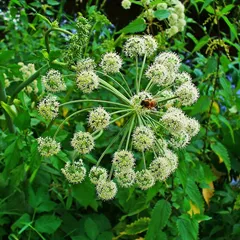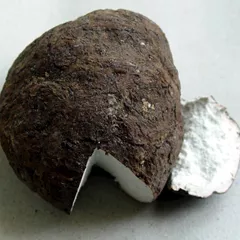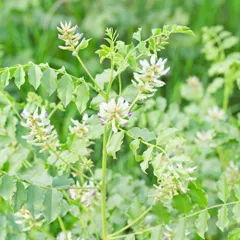Xiao Yao San
Chinese: 逍遥散
Pinyin: Xiāo Yáo Sàn
Other names: Rambling Powder, Bupleurum and Dang Gui Formula, Xiao Yao Wan




Xiao Yao San
Chinese: 逍遥散
Pinyin: Xiāo Yáo Sàn
Other names: Rambling Powder, Bupleurum and Dang Gui Formula, Xiao Yao Wan
Ingredients: 6 herbs
Category: Formulas that harmonize Liver-Spleen
- Harmonizes the function of Liver and Spleen
- Relieves Liver Qi stagnation
- Nourishes the Blood
Contraindications: Contraindicated for treating purely Deficient disorders.
Source: Formulary of the Pharmacy Service for Benefiting the People in the Taiping Era (1107 AD)
The information provided here is not a replacement for a doctor. You shouldn't use it for the purpose of self-diagnosing or self-medicating but rather so you can have a more informed discussion with a professional TCM practitioner.
Xiao Yao San is a 6-ingredient Chinese Medicine formula with Bupleurum Roots (Chai Hu) as a principal ingredient.
Invented in 1107 AD, it belongs to the category of formulas that harmonize Liver-Spleen. Its main actions are: 1) harmonizes the function of Liver and Spleen and 2) relieves Liver Qi stagnation.
In Chinese Medicine health conditions are thought to arise due to "disharmonies" in the body as a system. These disharmonies are called "patterns" and the very purpose of herbal formulas is to fight them in order to restore the body's harmony.
In this case Xiao Yao San is used by TCM practitioners to fight patterns like Liver Blood Stagnation, Liver Qi Deficiency or Rebellious Liver Qi invading the Spleen. From a Western Medicine standpoint, such patterns can give rise to a range of conditions such as menstrual cramps, low breast milk supply or irregular menstruation for instance.
On this page, after a detailed description of each of the six ingredients in Xiao Yao San, we review the patterns and conditions that Xiao Yao San helps treat.
The six ingredients in Xiao Yao San

Chai Hu is a king ingredient in Xiao Yao San. Like the name indicates, it means it has more power than other ingredients in the formula.
1. Bupleurum Roots (Chai Hu)
Chai Hu To spreads the Liver Qi, relieves Stagnation and helps guide the other herbs into the Liver. Because of its cooling nature, it is also particularly dealing with Qi Stagnation that has started to generate Heat.

Dang Gui is a deputy ingredient in Xiao Yao San. This means it helps the king ingredient(s) treat the main pattern or it serves to treat a coexisting pattern.
2. Dong Quai (Dang Gui)
Part used: Dried root
Nature: Warm
Meridian affinity: HeartLiverSpleen
Category: Tonic herbs for Blood Deficiency
Dang Gui works together with White peony roots, the other deputy in this formula, to nourish Blood. This nourishing role also in turn helps strengthen the Liver since it stores Blood and is nourished by it.

Bai Shao is a deputy ingredient in Xiao Yao San. This means it helps the king ingredient(s) treat the main pattern or it serves to treat a coexisting pattern.
3. White Peony Roots (Bai Shao)
Part used: Dried root
Nature: Neutral
Meridian affinity: LiverSpleen
Category: Tonic herbs for Blood Deficiency
In general Bai Shao's main actions are as follows: "Tonifies the Blood and preserves the Yin. Nourishes the Liver and assists in the smooth flow of Qi. Regulates the meridians and eases the pain."
In the context of Xiao Yao San, it is used because it moves Qi and is specific for menstrual problems, especially from emotional stress.

Fu Ling is an assistant ingredient in Xiao Yao San. This means that it either serves to reinforces the effect of other ingredients or it moderates their toxicity.
4. Poria-Cocos Mushrooms (Fu Ling)
Part used: Dried sclerotium
Nature: Neutral
Taste(s): Sweet
Meridian affinity: HeartKidneyLungSpleen
Category: Herbs that drain Dampness
In general Fu Ling's main actions are as follows: "Encourages urination and drains Dampness. Tonic to the Spleen/Stomach. Assists the Heart and calms the Spirit."
In the context of Xiao Yao San, it is used because it strengthens the Spleen.

Bai Zhu is an assistant ingredient in Xiao Yao San. This means that it either serves to reinforces the effect of other ingredients or it moderates their toxicity.
5. Atractylodes Rhizomes (Bai Zhu)
Part used: Dried rhizome
Nature: Warm
Meridian affinity: SpleenStomach
Category: Tonic herbs for Qi Deficiency
Bai Zhu works together with Poria mushrooms to strengthen the Spleen. Indeed, as described in the famous TCM treaty Essentials from the Golden Cabinet: "When one sees a Liver disorder, one knows that the Liver will transmit it to the Spleen. Therefore, one should first treat the Spleen." Strengthening the Spleen, since it 'rules transformation and transportation', has a direct positive impact on Blood Deficiency.

Gan Cao is an assistant ingredient in Xiao Yao San. This means that it either serves to reinforces the effect of other ingredients or it moderates their toxicity.
6. Liquorice (Gan Cao)
Part used: Dried root and rhizome
Nature: Neutral
Taste(s): Sweet
Meridian affinity: HeartLungSpleenStomach
Category: Tonic herbs for Qi Deficiency
Gan Cao tonifies the Spleen and, when combined with White peony roots (as is the case here), helps reduce the spasms that are often a symptoms for patients that use this formula.
Conditions and patterns for which Xiao Yao San may be prescribed
It's important to remember that herbal formulas are meant to treat patterns, not "diseases" as understood in Western Medicine. According to Chinese Medicine patterns, which are disruptions to the body as a system, are the underlying root cause for diseases and conditions.
As such Xiao Yao San is used by TCM practitioners to treat eight different patterns which we describe below.
But before we delve into these patterns here is an overview of the Western conditions they're commonly associated with:
Menstrual cramps Low breast milk supply Irregular menstruation Abnormal vaginal discharge Late menstruation Hepatitis Cholecystitis Peptic ulcers Gastric neurosis Chronic gastritis Cirrhosis Premenstrual syndrome Fibrocystic breasts Perimenopausal syndrome Pelvic inflammatory disease Uterine fibroids
Again it wouldn't be correct to say "Xiao Yao San treats menstrual cramps" for instance. Rather, Xiao Yao San is used to treat patterns that are sometimes the root cause behind menstrual cramps.
Now let's look at the eight patterns commonly treated with Xiao Yao San.

The Liver is a so-called "Zang" Organ. Learn more about the Liver in Chinese Medicine
Liver Blood Stagnation
Pulse type(s): Wiry (Xian)
Tongue color: Bluish-Purple sides
Symptoms: Dry skin Epistaxis Infertility Purple lips Purple face Purple nails Abdominal pain Painful period Abdominal masses Purple petechiae Vomiting of blood Hypochondrial pain Dark colored blood Irregular menstruation Dark clots in menstrual blood
Xiao Yao San is sometimes prescribed by TCM practitioners to treat Liver Blood Stagnation. This pattern leads to symptoms such as hypochondrial pain, abdominal pain, vomiting of blood and epistaxis. Patients with Liver Blood Stagnation typically exhibit wiry (Xian) pulses as well as Purple tongue or purple spots on sides. .
Liver Blood Stagnation usually develops from other patterns and Liver Qi Stagnation, Cold and Heat are the three most common ones. Sometimes Qi Deficiency, Blood Deficiency and Phlegm can also be the precursors.
Liver Qi Stagnation is the most common cause. If left unchecked for a while without... read more about Liver Blood Stagnation

The Liver is a so-called "Zang" Organ. Learn more about the Liver in Chinese Medicine
Liver Qi Deficiency
Pulse type(s): Weak (Ruo)
Symptoms: Fatigue Timidity Dizziness Indecision Depression Nervousness Irritability Easily scared Poor appetite Blurred vision Lack of courage Restless dreams Floaters in eyes Frequent sighing Abdomen distension Irregular menstruation Hypochondrial distention
Xiao Yao San is sometimes prescribed by TCM practitioners to treat Liver Qi Deficiency. This pattern leads to symptoms such as dizziness, blurred vision, floaters in eyes and nervousness. Patients with Liver Qi Deficiency typically exhibit weak (Ruo) pulses.
It is more common to see Liver Qi Deficiency accompanying other patterns.
The most obvious one is Liver Qi Stagnation. One of Liver's main functions is to ensures the smooth flow of Qi throughout the body, in all Organs and in all directions. This function is impaired when the Qi in Liver is... read more about Liver Qi Deficiency

The Liver is a so-called "Zang" Organ. Learn more about the Liver in Chinese Medicine
Rebellious Liver Qi invading the Spleen
Pulse type(s): Weak (Ruo), Wiry (Xian)
Symptoms: Tiredness Flatulence Irritability Abdominal pain Abdominal distension Alternating constipation and diarrhea Stools sometimes dry and in small pieces
Xiao Yao San is sometimes prescribed by TCM practitioners to treat Rebellious Liver Qi invading the Spleen. This pattern leads to symptoms such as irritability, abdominal distension, abdominal pain and alternating constipation and diarrhea. Patients with Rebellious Liver Qi invading the Spleen typically exhibit weak (Ruo) or wiry (Xian) pulses.
Liver Qi is said to be rebellious when its horizontal movement is accentuated. This impairs the Spleen's function of transformation and transportation and prevents Spleen Qi from rising.
It is a pattern of mixed Deficiency and Excess: Excess of the Liver (Rebellious Qi) and Deficiency of Spleen... read more about Rebellious Liver Qi invading the Spleen

'Heat' as a body pattern in Chinese Medicine is one of the so-called "Eight Principles". Learn more about Heat pattern in Chinese Medicine
Damp-Heat
Pulse type(s): Soggy (Ru)
Symptoms: Acne Fever Thirst Fatigue Hot body Headaches No thirst Dry mouth Dizziness Red urine Joint pain Heavy head Late period Restlessness Loose stools Heavy periods Poor appetite Chest pressure Feeling of heat Sore lower back Vaginal itching Aversion to cold Frequent sighing Vaginal discharge Abdominal fullness Frequent urination Swollen neck glands Abdominal tightness Sore and weak limbs Feeling of heaviness Lower abdominal pain Scanty dark urination Thick menstrual blood Scanty and dark urine Trichomonas infection Irregular menstruation Thermophilus infection Feeling of bearing down Purplish menstrual blood Smelly Vaginal discharge Sticky vaginal discharge Sticky taste in the mouth Bitter taste in the mouth Small clots in menstrual blood Yellow or brown vaginal discharge Stifling sensation in the chest and epigastrium
Xiao Yao San is sometimes prescribed by TCM practitioners to treat Damp-Heat. This pattern leads to symptoms such as fever, swollen neck glands, headaches and stifling sensation in the chest and epigastrium. Patients with Damp-Heat typically exhibit soggy (Ru) pulses.
Within the Four-Levels theory, Damp-Heat is the first level of invasion of External Pathogens, when it still resides in the body's Exterior.
The general symptoms of Damp-Heat are the heaviness of the body and head as well as low temperature fever rising in the afternoon. The patients are not hot on... read more about Damp-Heat

Qi is one of Chinese Medicine's vital subtances. Learn more about Qi in Chinese Medicine
Qi And Blood Stagnation
Pulse type(s): Choppy (Se), Deep (Chen), Fine (Xi)
Symptoms: Melasma Insomnia Dark face Moodiness Dizziness Chest pain Depression Amenorrhea Purple lips Mood swings Breast pain Hot flushes Purple nails Irritability Blotchy skin Restlessness Breast lumps Restlnessness Chest fullness Painful period Scanty periods Clots in blood Abdominal pain Abdominal masses Lochia retention Breast distention Dark colored blood Abdominal fullness Intense period pain High blood pressure Swelling of the feet Lower abdominal pain Dark menstrual blood Flooding and leaking Abdominal distension Pre-menstrual tension Black and tarry stools Irregular menstruation Boring fixed stabbing pain Pre-menstrual irritability Dark clots in menstrual blood Menstruation decreases gratually Feeling of fullness in the chest Abdominal distention and fullness Pain relief after clots discharge
Xiao Yao San is sometimes prescribed by TCM practitioners to treat Qi And Blood Stagnation. This pattern leads to symptoms such as chest fullness, chest pain, boring fixed stabbing pain and dark face. Patients with Qi And Blood Stagnation typically exhibit choppy (Se), deep (Chen) or fine (Xi) pulses.
The typical symptoms of Qi stagnation are distension, oppression and swelling. There are also emotional issues like mood swing, depression or irritability. However, the Blood Stagnation is more on pains and purple color manifestation on skin, face, lips and nails.
Qi Stagnation can cause the... read more about Qi And Blood Stagnation

The Liver is a so-called "Zang" Organ. Learn more about the Liver in Chinese Medicine
Liver Qi Stagnation
Pulse type(s): Wiry (Xian)
Tongue color: Normal (light red)
Symptoms: Anger Fever Nausea Sighing Anxiety Melasma Blister Vomiting Diarrhea Belching Moodiness Hiccuping Headaches Dark face Melancholy Depression Borborygmi Neck lumps Flank pain Mood swings Fluctuation Breast pain Irritability Breast lumps Constipation Poor appetite Breast eczema Abdominal pain Epigastic pain Breast redness Breast nodules Scanty periods Clots in blood Breast hardness Chest distension Menstrual cramps Frequent sighing Breast distention Dark nipple color Thick breast milk Abdomen distension Hypochondriac pain Clogged milk ducts Breast skin cracks Uneven milk supply Dark colored blood Suppressed emotions Premenstrual tension Breast pus discharge Breast skin ichiness Abdominal distension Lower abdominal pain Feeling of distension Epigastric distension Pre-menstrual tension Epigastrium distension Irregular menstruation White spots on nipples Feelings of frustration HypochondriaI distension Yellow vaginal discharge Sticky vaginal discharge Alternating fever and chills Feeling of lump in the throat Premenstrual breast distension Churning feeling in the stomach Abdominal distention and fullness Feeling of pulsation in epigastrium Alternating constipation and diarrhea Insufficient or absent lactation after childbirth Stifling sensation in the chest causing one to have deep sighs
Xiao Yao San is sometimes prescribed by TCM practitioners to treat Liver Qi Stagnation. This pattern leads to symptoms such as hypochondriai distension, chest distension, epigastrium distension and abdomen distension. Patients with Liver Qi Stagnation typically exhibit wiry (Xian) pulses as well as Normal or slightly red on the sides.
When Liver Qi does not flow smoothly or regularly, it becomes Stagnant and in Excess. This leads to Heat accumulating in the Liver. This affects not only the Liver, but other connected Organs as well as the Seven Emotions.
Liver Qi Stagnation is not only the most seen Liver disharmony, but also one... read more about Liver Qi Stagnation

Qi is one of Chinese Medicine's vital subtances. Learn more about Qi in Chinese Medicine
Qi Stagnation
Pulse type(s): Tight (Jin), Wiry (Xian)
Tongue coating: Thin white coating
Tongue color: Red sides
Symptoms: Belching Vomiting Depression Mood swings Acid reflux Indigestion Late period Irritability Throat lumps Poor appetite Scanty periods Clots in blood Abdominal pain Frequent sighing Breast distention Soft palpable lumps Feeling of distension Moving distending pain Irregular menstruation Fixed pain in the hypochondria Premenstrual breast distension Mild coughing with copious sputum Premenstrual abdominal distension Feeling of oppression of the chest Stifling sensation in the chest and abdomen
Xiao Yao San is sometimes prescribed by TCM practitioners to treat Qi Stagnation. This pattern leads to symptoms such as feeling of distension, moving distending pain, depression and irritability. Patients with Qi Stagnation typically exhibit tight (Jin) or wiry (Xian) pulses as well as Normal or slightly dark on side with white or yellow coating.
If the flow of Qi is impeded in any way, it becomes stuck or stagnant. This can be likened to a traffic jam on the freeway. That's why, unlike in the cases of Qi Deficiency or Qi Sinking, tonification is contraindicated: it would be like adding more cars to the traffic jam. Instead, Qi moving or... read more about Qi Stagnation

The Liver is a so-called "Zang" Organ. Learn more about the Liver in Chinese Medicine
Blood Deficiency with disharmony of Liver and Spleen
Pulse type(s): Empty (Xu), Wiry (Xian)
Tongue color: Pale
Symptoms: Anemia Vertigo Dizziness Headaches Dry mouth Chest pain Dry throat Leukorrhea Poor appetite Chest fullness Breast distention Irregular menstruation Alternating fever and chills
Xiao Yao San is sometimes prescribed by TCM practitioners to treat Blood Deficiency with disharmony of Liver and Spleen. This pattern leads to symptoms such as chest fullness, chest pain, anemia and dizziness. Patients with Blood Deficiency with disharmony of Liver and Spleen typically exhibit empty (Xu) or wiry (Xian) pulses as well as a pale tongue.
Learn more about Blood Deficiency with disharmony of Liver and Spleen
Formulas similar to Xiao Yao San
Dan Zhi Xiao Yao San is 75% similar to Xiao Yao San
Jia Wei Xiao Yao San is 60% similar to Xiao Yao San
Dang Gui Shao Yao San is 57% similar to Xiao Yao San
Ba Zhen Yi Mu Tang is 56% similar to Xiao Yao San
Si Jun Zi Tang is 50% similar to Xiao Yao San
Liu Jun Zi Tang is 50% similar to Xiao Yao San













